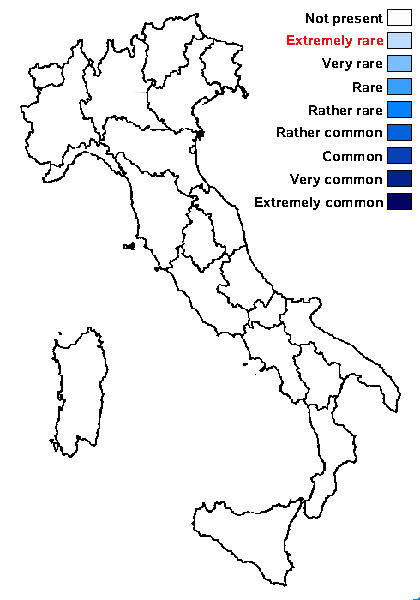Chaenotheca sphaerocephala Nádv.
Ann. Mycol. 40, 1/2: 134, 1942
Synonyms:
Distribution:
Description: Thallus crustose, episubstratic, finely granular (granules 0.4-0.6 mm) or of verrucose granules (0.12-0.15 mm), ecorticate. Apothecia stalked, pin-like, the stalk 1.1-1.5 mm high, 0.04-0.11 mm thick, black but often covered in a thin, greyish pruina formed by a layer of ruptured surface hyphae. Capitulum globose, 0.3-0.4 mm across, with a poorly developed, up to 30 µm thick exciple which only surrounds the base of the capitulum as a collar, sometimes missing. Mazaedium well-developed, brown, without crystalline pruina, but the lower side of the capitulum sometimes white-pruinose due to pale hyphae projecting from the exciple; hypothecium broadly obconical, with a strongly convex to hemispherical upper surface. Asci cylindrical, ellipsoid or irregular, stipitate, formed in chains, dissolving early, with 1-2-seriately arranged spores. Ascospores 1-celled, brown to pale brown, globose, 3-4.5 µm wide, the wall smooth or with irregular fissures. Photobiont chlorococcoid, trebouxioid, the cells < 10 µm diam. Spot tests: thallus K-, C-, KC-, P- or P+ yellowish(-orange), UV+ white. Chemistry: thallus with barbatic and obtusatic acids, rarely with squamatic acid.Note: described from South America, this species is widespread in temperate and cool-temperate areas of the Southem Hemisphere, rare in the Northern Hemisphere, in Europe being known from a few localities scattered from Scandinavia to the montane belt of the Central Alps (Switzerland), in very shaded localitites at bases of old trunks. To be looked for in Italy.
Growth form: Crustose
Substrata: bark
Photobiont: green algae other than Trentepohlia
Reproductive strategy: mainly sexual

Predictive model
Growth form: Crustose
Substrata: bark
Photobiont: green algae other than Trentepohlia
Reproductive strategy: mainly sexual

Predictive model



